
views
Choosing Your Position

Make sure your topic is arguable. If you are choosing your own topic, then you will want to make sure that it has multiple sides. The topic should be controversial, with at least 2 clear sides. Sometimes a topic might seem to have 2 sides, but in actuality most people would agree on 1 side. For example, you wouldn’t want to write a paper arguing that children need proper care, as no one would disagree with that stance. A better topic may be taking a stance on what should be done if children are not receiving proper care.

Research your topic and the alternative sides. You need to fully understand your issue in order to choose and defend a position. Consider the background information, recent developments, and the reasons behind each side. Remember to examine at least 2 sides of your issue. Visit your local library to find books, journals, and newspapers. Access online databases, credible websites, and news sources. To decide if a source is credible, look for peer-reviewed journals, check the credentials of the author, locate the information in two separate sources, and check the date to make sure the information is the most recent available. You should also avoid self-published sources.
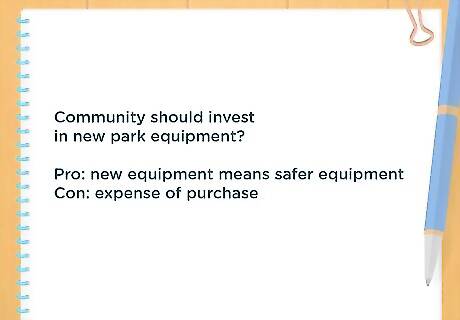
Make a pros and cons list for at least 2 positions on your topic. Based on your research, write down the reasons for and against each position that you are considering taking. This will help you choose a position that is easy to defend using the evidence that you have collected. Looking at both sides not only helps you pick the best position, it will also help you choose a good counterargument. For example, if you are writing a paper about whether or not your community should invest in new park equipment, your two sides would be either in favor of the new park equipment or against it. A pro of buying new equipment might be purchasing safer equipment, while a con would be the expense of the purchase.

Think about your views on the issue. You may have strong views on the topic, which could help guide your choice. If you do have an opinion, make a list of the reasons behind it to see if they can help you build an argument. In some cases, it’s easier to argue a position if you don’t have strong opinions either way. This is because you can focus on the evidence, not on your personal views.

Consider your audience's views on the topic. How your paper is received will depend on the audience and their stance on the issue. If you are preparing your paper for a class, it could be helpful to consider the views of your instructor. Similarly, a paper such as a policy paper would benefit from localizing the issue, just as a paper for an international journal would appeal to more readers if it includes a wider worldview. While you don’t have to change your position to fit your audience, you may want to adjust your reasons behind the position or the counter-argument you choose.
Building Your Argument

Establish your claim. Your claim is your position on the topic, which is what you will defend in your paper. You should base your claim on what you can prove with your evidence.
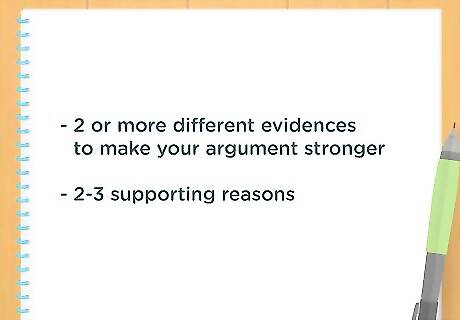
Identify your supporting reasons. Most position papers provide 2 or 3 supporting reasons for your claim, but a longer paper may include more reasons. Your supporting reasons will come directly from your evidence, so choose statements that you can prove. If possible, look for supporting reasons that are shown through 2 or more different pieces of evidence, as this will make your argument stronger. Use your assignment sheet or the parameters of your paper to determine how many supporting reasons you should include. For many academic papers, you will use 2 to 3 reasons.

Compile your supporting evidence. Identify which pieces of evidence you will use to support your argument, and mark them in a way that is convenient for you. For example, you could write your citations on index cards for use while you write the paper, or you could type them directly into a document and then copy-and-paste them into your paper when you reach the drafting phase. Use an organizing strategy that works for you. Compiling your evidence now will help you more easily write your paper. Keep in mind that it is important to cite your sources. If you use a direct quote from a source, then put it into quotation marks and identify the author when you use it. If you paraphrase or summarize something from a source, give credit to the author for the ideas. Don’t go overboard on including evidence! Remember that most of the ideas in the paper should be your own. It’s good to quote sources, but avoid quoting entire paragraphs from other sources. Keep your quotes to a sentence or two and try to avoid including more than one quote per paragraph.
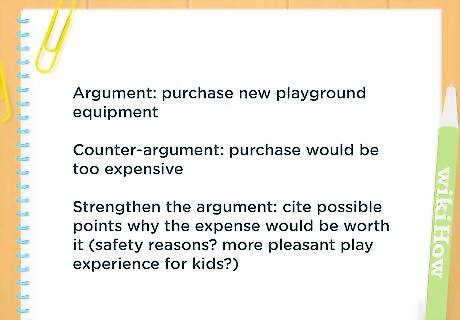
Identify a counter-argument that you can easily dismiss. Using a counter-argument can help you strengthen your claim because it shows the audience that you have considered other options. By introducing and then dismissing the counter-argument, you are showing that your position is the correct one to take. A good counter-argument is easy to dismiss, allowing you to refute it using your evidence. For example, if you are writing a position paper arguing that your community should purchase new playground equipment, your counter-argument could be that the purchase will be too expensive. To strengthen your argument, you would cite this possible point against you but show why it's not a valid reason to dismiss your position. A good way to do that would be to show that the equipment is worth the expense or that there is outside funding to pay for it. You will also want a piece of evidence that supports your counter-argument. This evidence, which should be easy to dismiss, will be included in your paper.
Drafting Your Paper
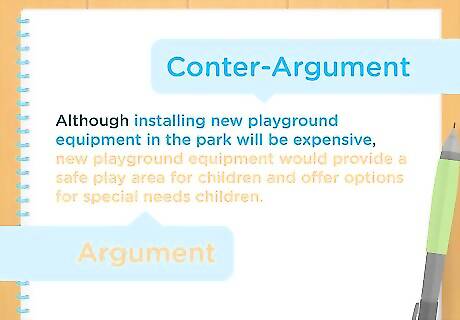
Develop your thesis. Your thesis will control your paper, so you should write it first. For a position paper, you can vary how you write your thesis. Since you are using a counter argument, you may only have two supporting points, depending on the requirements of your paper. One easy way to set up your argument in your thesis is to include both your counter-argument and claim, preceded by the word “although.” For example, “Although installing new playground equipment in the park will be expensive, new playground equipment would provide a safe play area for children and offer options for special needs children.” If you’re an expert writer, you may not need to include supporting reasons in your thesis. For example, “As parents learn the benefits and dangers of outside play, communities across the nation are turning their eyes toward their parks, making safe, accessible equipment a public necessity.”
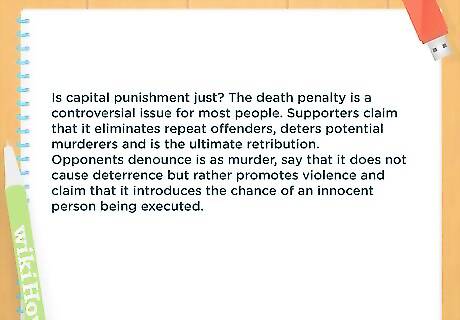
Write your introduction. Provide your audience with background information on your topic, including the history and recent developments. You should include information that is relevant for your stance, which will narrow what you tell the reader. For example, if you are writing a paper about gay marriage in Maine, you would only include background information relevant to that state. Start with a hook that introduces your topic. For example, you could provide a statistic of how many children are injured on old playground equipment every year. Include a few sentences that provide more information on your topic, narrowing down toward your stance. End your introduction with your thesis.
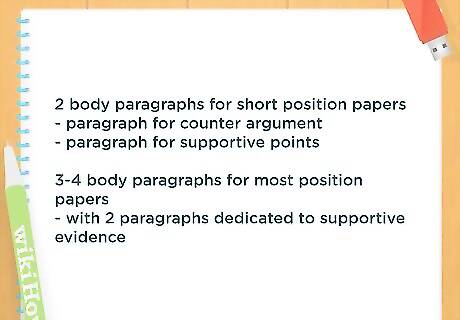
Include at least 2 body paragraphs. A short position paper may only contain 2 body paragraphs - one for the counter-argument and one for the supportive points. However, most position papers will have 3 or 4 body paragraphs, with 2 dedicated to supportive evidence. Depending on the length of your paper, you may decide to include more. Follow the requirements for your paper, which may state how many paragraphs you should include.
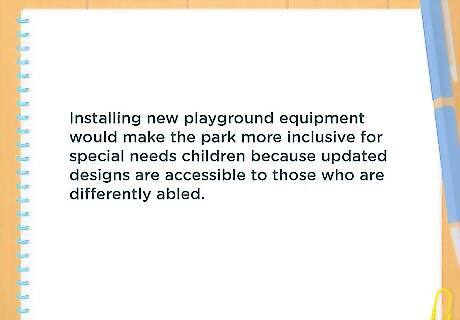
Use topic sentences that link back to your thesis. Each body paragraph should begin with a topic sentence. The topic sentence is like a mini-thesis that controls your whole paragraph. Your topic sentence should introduce what you will talk about in the paragraph, whether it’s the counter-argument or one of your supporting reasons. For example, you could write: “Installing new playground equipment would make the park more inclusive for special needs children because updated designs are accessible to those who are disabled.”
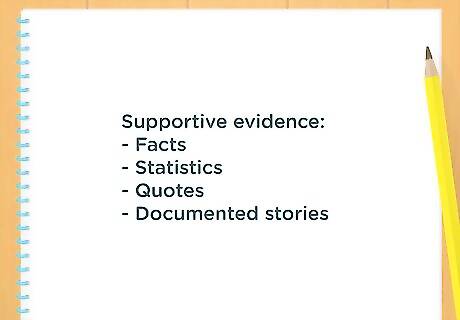
Provide evidence to support your position. Each of your reasons needs at least 1 piece of evidence, though using more evidence will strengthen your argument. Pull your evidence from your research, focusing on the following: Facts Statistics Quotes Documented stories

Provide commentary to explain your evidence. Commentary explains to the reader why your evidence supports your reason and your position, so your commentary should clearly explain the link between your evidence and thesis. In your own words, tell the reader what you want them to take away from this piece of evidence, and why it proves that you are correct. You should include 2 to 5 sentences of commentary for each piece of evidence. Without commentary, there is no link between your evidence and your position, leaving your argument weak.
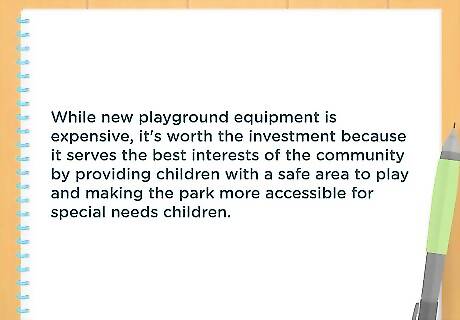
Conclude your essay by reasserting your position. A strong conclusion restates your position and the reasons why it’s the correct viewpoint. You will summarize your argument and briefly dismiss your counter-argument. In a position paper, you’ll also want to end with a call to action. Restate your thesis. For example, "While new playground equipment is expensive, it's worth the investment because it serves the best interests of the community by providing children with a safe area to play and making the park more accessible for special needs children." Sum up your argument. End on a high note with a call to action. For example, "Children need a safe, accessible place to play, so the only choice is to install new park equipment in Quimby Park."
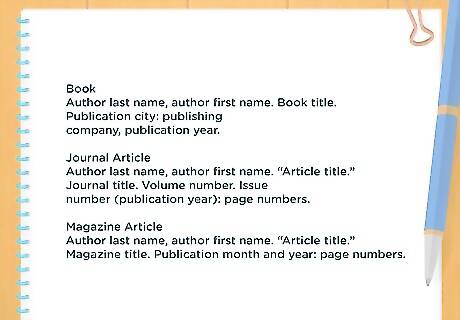
Cite your sources. Since your position paper will contain evidence, you need to include where you sourced that information. Follow the preferred citation style of the recipient of your paper, whether that’s an instructor, organization, journal, or other entity. If you don’t cite your sources, then you will be guilty of plagiarism. You could lose credit or face harsher penalties if you are caught stealing someone else’s words or ideas.
Revising and Editing Your Paper

Use your spell check tool. The spell check tool is the easiest way to avoid misspellings, and it’s available on most word processors. Remember that you will still need to proofread your paper because the spell check tool will not catch words that are spelled correctly but used incorrectly, such as “form” instead of “from.” Before you change a word, re-read the sentence to make sure that the new suggestion fits. The spell checker may think that you mean one thing, while you really mean something else.

Take a break from your paper. Go for a walk, eat a snack, take a nap, or participate in a relaxing hobby. Your brain needs rest before you try to edit your paper. By stepping away, you’ll have more insight into gaps in your argument and whether or not your sentences make sense. Waiting at least a day is best. If you are short on time, wait at least 30 minutes before reviewing what you’ve written.

Re-read your paper with fresh eyes. Read through your paper as a reader rather than the writer. Identify your claim, counter-argument, and support. Look for areas that need development or additional evidence. Mark sentences that need to be rewritten to streamline or provide more clarity. If possible, have a friend or mentor read your paper and suggest edits or revisions.

Revise your paper. Start by making any additions, such as more evidence to support your argument or additional commentary. Make sure that your argument is clear, supported by evidence, and restated in the conclusion. Then go back through your paper and rewrite awkward sentences, as well as sentence fragments and run-ons. Combine short, choppy sentences, and break up long sentences. Fix sentence fragments and run-ons.

Proofread your paper to make final edits. Check your final draft for typos, misspellings that the spell check tool missed, and any remaining grammar issues. If possible, ask a friend or mentor to proofread your final draft. They may be able to spot errors that you don’t see.
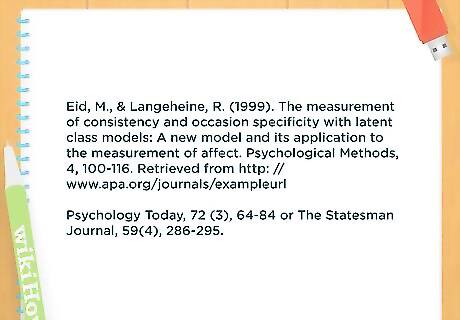
Prepare your works cited page, bibliography, or references page. Since you will likely be using evidence, you will need to include a page listing all of your sources. You should prepare this page using the style manual prefered by your instructor.

Format your paper to fit your instructor’s requirements. Consult your assignment sheet, syllabus, or the parameters of the paper for how you should format your paper. Adjust the margins, font size, and spacing to match the format requirements. Then add your heading and page numbers. If you are presenting or turning in a printed paper, check to see if you should place it in a presentation folder.



















Comments
0 comment